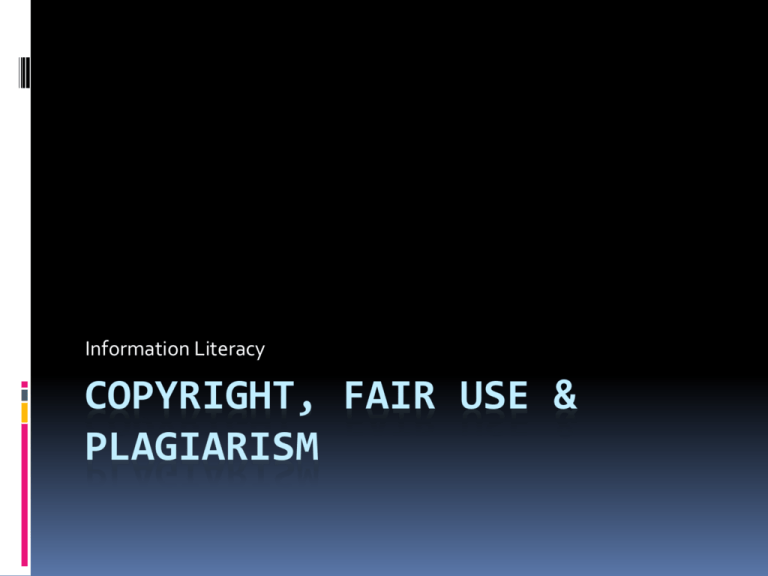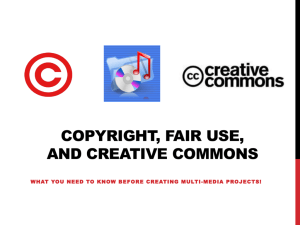
Information Literacy
COPYRIGHT, FAIR USE &
PLAGIARISM
Think About the following
questions…
Write your responses down on a blank sheet of
paper.
What is something you’ve made that you’re
proud of?
Can you think of a time when you used
someone else's work in something you
created?
Nicole’s Story-Copyrighting
Creative Work
Nicole’s Story Follow-Up
Questions
Why does Nicole
want to share her
writing online? What
are the benefits for
her?
What are the risks of
Nicole sharing her
writing online?
Copyright Basics
Once someone records an original idea, it is
copyrighted.
Copyright is an important law that helps
protect the rights of creators so they receive
credit and get paid for their work.
Most things you find, download, copy and
paste from the Internet are copyrighted.
Copyright Basics (cont.)
You can use things you find online as long as
you:
check who created it
get permission to use it
give credit to the creator
buy it (if necessary)
use it responsibly
Copyright Basics
If you aren’t careful in how you use
other people’s work online, you
might be stealing.
It’s great to be able to use things
we find online, but we have to do it
responsibly.
We have to show our respect for
other people’s hard work and
creativity by giving credit where
credit is due.
Definitions Review
The terms on your Creator’s Rights
definition sheet are important for creators
to know so that they can:
protect their own creative work
follow the rules of copyright law
be respectful of how they use other people’s work
Intro Video
Copyright & Creative Commons
Creative Work
Any idea or artistic creation that is recorded in
some form, whether it’s hard copy or digital
Additional background:
As a creator, you’ve probably written, photographed,
filmed, or made many artistic creations throughout
your life.
Any idea you put down – whether it’s your best idea or
not, and whether it’s in hard copy form or not – counts
as creative work.
Examples: pieces of writing (books, poems, papers,
articles, blogs, reviews, etc.), photos, videos, music,
websites, online profiles, and artworks.
Copyright
A law that protects your control over the creative work you make
so that people must get your permission before they copy, share,
or perform
Additional background:
When you have an idea and record it, it’s instantly copyrighted. You have
the right to decide how others use your creative work. Nobody else can
pretend it’s theirs – or copy, share, or perform your work without your
permission. Copyright makes sure you get credit for your work.
It does not matter if a work is in hard copy or digital form, it is still
copyrighted.
All recorded work is automatically copyrighted, even if it doesn’t have
the “C” copyright symbol. Registering your work with the U.S. Copyright
Office isn’t necessary, but it makes it easier for legal protection.
Ideas, common knowledge and facts, U.S. government documents,
works in the public domain, and spontaneous acts of expression aren’t
copyrighted.
If someone wants to use a copyrighted work, unless it says otherwise,
they have to first get permission from the creator. To get permission, you
can email, call, or write a letter to the creator. (The only exceptions to
this are fair use, public domain, and Creative Commons.)
Creative Commons
A kind of copyright that makes it easier for people to copy, share,
and build on your creative work, as long as they give you credit
for it
Additional background:
The key here is that a regular copyright is an “all rights reserved” model,
and Creative Commons is a newer, “some rights reserved” model more
suitable for online sharing. If someone uses a Creative Commons license,
they are allowing for more flexibility with their copyrighted work to be
copied and shared.
There are different kinds of Creative Commons licenses that allow
people to do things such as change, remix, or make money from your
work. You pick and choose how you want your work to be used, and then
create a Creative Commons license (which function as symbols) that you
include in your work. For instance, you might say someone can use your
work as long as that person doesn’t make a profit from it, or as long as
the person doesn’t alter or change it.
It is important in all cases to acknowledge and give credit to the work
you use – whether it is regular copyright, Creative Commons, or fair use.
License
A clear way to define the copyright of your
creative work so people know how it can be
used.
Additional background:
You probably know that you need a license to drive a
car. The license gives people permission to drive.
In the same way, when you have a copyright license,
this tells people how they have permission to use your
copyrighted work. You might use a regular copyright
license, or you might use a Creative Commons license.
Some creators charge a “license fee” to others who
want to use their copyrighted work, which helps them
get credit and make money from the usage.
Piracy
Stealing copyrighted work by downloading or
copying it in order to keep, sell, or give it away
without permission and without paying
Additional background:
Piracy includes illegally downloading, copying, and sharing
creative works such as music, movies, games, and software
by using peer-to-peer sharing websites and programs that
“rip” content.
Piracy is illegal, and you can face heavy fines or other legal
consequences for engaging in it. It’s called piracy because
it’s stealing.
To avoid unintentional piracy, use trusted online sites to
purchase content. You can also find sites that allow you to
get content for free.
Plagiarize
Copying, “lifting,” or making slight changes to some
or all of someone else’s work and saying you created
it
Additional background:
As all teachers know, plagiarism is a huge problem in
schools. Talk to your librarian about how your school
handles plagiarism, as well as how students should properly
cite information.
If you copy, paste, or change a few words of something and
say that you wrote it, it is still plagiarism.
To avoid plagiarism, be sure to say things in your own
words, cite direct quotes by using quotation marks, and
acknowledge the authors’ ideas you discuss by giving them
credit.
Public Domain
Creative work that’s not copyrighted and therefore free for
you to use however you want
Additional background:
Copyrights don’t last forever. In most cases, they expire 70
years after the death of the creator. So things that are
hundreds of years old are not copyrighted anymore.
There are many creative works available in the public
domain that you might not know about. When searching
for photos, music, artwork, and video, look for the ones
that are in the public domain. Ask the librarian about public
domain content available through the school. For example,
Wikipedia has a list of public domain images resources.
Fair Use
The ability to use a small amount of
copyrighted work without permission, but
only in certain ways and in specific situations
(schoolwork and education, news reporting,
criticizing or commenting on something, and
comedy/parody)
Fair Use
Fair use can only be applied in certain situations and in
certain ways.
In specific situations:
Schoolwork and education
News reporting
Criticizing or commenting
Comedy and parody
In certain ways:
Using a small amount (not the whole thing)
Adding new meaning and making it original. (The work should
not be copied and pasted but used to help students express their
own ideas.)
Reworking and using material in a different way. (The work
should be “reworked” in a new way, different from the original
purpose and context.)
Fair Use
Fair use means that using copyrighted works in
specific situations does not require permission, and
it allows you to build on, rework, and comment on or
critique the creative work of others.
Fair use is not a clear-cut issue, but requires critical
thinking and depends on the specific situation.
In all instances, fair use has to do with reworking the
copyrighted work in a way that makes something new and
original.
You should be able to defend that something is fair
use by making sure it falls under the specific
situations allowed and is used in the approved ways.
Definitions Review…Again!
These terms are important for creators to
know so that they can:
protect their own creative work
follow the rules of copyright law
be respectful of how they use other people’s work
Parody & Review Video
Michael Jackson: Beat It
Weird Al Yankovic: Eat It
Ice Ice Baby: Vanilla Ice
Under Pressure: Queen & David Bowie
A Fair(y) Use Tale: Disney Parody
Ask, Acknowledge, Add Value
When using the creative works of others, you
should…
ASK- How does the author or artist say I can use
the work? Do I have to get the creator’s
permission first?
ACKNOWLEDGE- Did I give credit to the work I
used?
ADD VALUE- Did I rework the material to make
new meaning and add something original?
Copyright & Songs
What is a song that we all have sung at one
point in our lives?
In your small groups, read The Truth About
“Happy Birthday” page in your packet and
follow the directions carefully.
Be prepared to present your original song to
the rest of the class.
Happy Birthday Variations
12 song mix
Best Birthday Songs
Jimi Hendrix
Animal Mix
Katy Perry
Free Music Archive
B.B. King
Click Five
Rihanna
Ting Tings
Solomon Burke
Creative Commons
A kind of copyright that makes it easier for people to copy, share,
and build on your creative work, as long as they give you credit
for it
Additional background:
The key here is that a regular copyright is an “all rights reserved” model,
and Creative Commons is a newer, “some rights reserved” model more
suitable for online sharing. If someone uses a Creative Commons license,
they are allowing for more flexibility with their copyrighted work to be
copied and shared.
There are different kinds of Creative Commons licenses that allow
people to do things such as change, remix, or make money from your
work. You pick and choose how you want your work to be used, and then
create a Creative Commons license (which function as symbols) that you
include in your work. For instance, you might say someone can use your
work as long as that person doesn’t make a profit from it, or as long as
the person doesn’t alter or change it.
It is important in all cases to acknowledge and give credit to the work
you use – whether it is regular copyright, Creative Commons, or fair use.
Video About Creative Commons
Copyright Detectives
Turn to the Copyright Detectives page in your
Creator’s Rights packet.
Read the directions carefully.
Have a pencil ready to copy down
information from the video clip we watch
next.
Use this web address on your Copyright
Detectives page:
https://creativecommons.org/licenses/
Whose Is It Anyway?
Review Questions
Why is it important to give credit when using
other people’s creative work?
Why can’t you directly copy information from
an online source such as Wikipedia?
Why do you seldom hear “Happy Birthday to
You” sung on a TV show or in a movie?
Now, turn to the back page of your
Creator’s Rights packet and answer the
three questions.
Sources
Common Sense Education (2014), A Creator's
Rights (6-8), Retrieved from
https://www.commonsensemedia.org/educat
ors/lesson/creators-rights-6-8
Learn More About Citing
Sources
Cyberbee
http://www.cyberbee.com/citing_sites.htm
Brainpop
http://www.brainpop.com/english/writing/citingso
urces/





